I’m bigger than you Yeast and you will make my bread rise!
I’ve been eyeing the Daring Bakers posts that come out in so many of the blogs I read and have been wanting to join for a couple months now. It would be a great opportunity to push myself harder in the kitchen. So I signed up and am part of the November class of newbies. The days leading up to the announcement of the challenge, I told hubby about the group. We pondered what the challenge would be. I told him there are 2 things that scare me the most in the kitchen. Yeast and gelatin. Then it came, the challenge announcement – Potato bread. My heart fluttered as I realized that I was going to have to embrace daring baker inside of me and show yeast who was boss.  It was a dark and stormy afternoon in Boston. It was merely 2 days after the announcement, and I headed out into the storm to get the ingredient to attempt my potato bread. I wanted to get a head start in case I needed a couple trials at the bread. Hubby was working and the remains of hurricane Noel were hitting Boston. I bundled up and headed to Trader Joe’s to get my flour, yeast, and potatoes. When I got home, I realized 2 things. I should have asked to get the flour in plastic bags because my market tote provided no protection from the rain. And, carrying 2 bags of flour and a bag of potatoes is a lot of work! My arms were tired.
It was a dark and stormy afternoon in Boston. It was merely 2 days after the announcement, and I headed out into the storm to get the ingredient to attempt my potato bread. I wanted to get a head start in case I needed a couple trials at the bread. Hubby was working and the remains of hurricane Noel were hitting Boston. I bundled up and headed to Trader Joe’s to get my flour, yeast, and potatoes. When I got home, I realized 2 things. I should have asked to get the flour in plastic bags because my market tote provided no protection from the rain. And, carrying 2 bags of flour and a bag of potatoes is a lot of work! My arms were tired.  I printed my recipe and read it twice. I didn’t want to miss anything. I read up on all the questions and comments other people made about the recipe. I took notes on my printout. Then I put them in plastic sleeves and headed to the kitchen.
I printed my recipe and read it twice. I didn’t want to miss anything. I read up on all the questions and comments other people made about the recipe. I took notes on my printout. Then I put them in plastic sleeves and headed to the kitchen.
 I got out all the tools I would need and pre-measured all the ingredients. I didn’t want to find myself covered in dough and needing to get something out of a cabinet. I was going to do whatever it took to make this bread and make it right!
I got out all the tools I would need and pre-measured all the ingredients. I didn’t want to find myself covered in dough and needing to get something out of a cabinet. I was going to do whatever it took to make this bread and make it right!
 While I was prepping my tiny kitchen for the task at hand, I used a trick I read in a blog somewhere. I put my measuring cup into my colander so that when I drained my potatoes I would remember to save off the potato water. Great idea. I’d love to give credit if I could remember which blog I read that in. If it was you, speak up!…
While I was prepping my tiny kitchen for the task at hand, I used a trick I read in a blog somewhere. I put my measuring cup into my colander so that when I drained my potatoes I would remember to save off the potato water. Great idea. I’d love to give credit if I could remember which blog I read that in. If it was you, speak up!…
 The first challenging part of was figuring out how many potatoes to use. The recipe says 8-16 ounces and recommends that beginners use only 8. I am definitely a beginner so 8 ounces it is. But, I don’t have a scale at home! So I divided my 5 lb bag into 5 equal-sized groups of potatoes. Assuming that a pound is 16 ounces, then I should have used half of one of my little groups. That was my plan and until I started writing up this blog entry, that is what I thought I did, but in fact I didn’t take 1/2 of one of my groups of potatoes, I took a whole group! I used 16 oz of potato!! It was 3 potatoes for me. Here’s what they looked like all peeled and cubed and boiling. Aren’t they pretty?
The first challenging part of was figuring out how many potatoes to use. The recipe says 8-16 ounces and recommends that beginners use only 8. I am definitely a beginner so 8 ounces it is. But, I don’t have a scale at home! So I divided my 5 lb bag into 5 equal-sized groups of potatoes. Assuming that a pound is 16 ounces, then I should have used half of one of my little groups. That was my plan and until I started writing up this blog entry, that is what I thought I did, but in fact I didn’t take 1/2 of one of my groups of potatoes, I took a whole group! I used 16 oz of potato!! It was 3 potatoes for me. Here’s what they looked like all peeled and cubed and boiling. Aren’t they pretty?
 I mashed my potatoes up with a pastry cutter and added the reserved potato water. I only had about 1.5 cups from the pot, so I had to add more to make the 3 cups. We were given 2 options to add the yeast. I added it to the flour and then added the flour/yeast mixture to my potato/water mixture. After I mixed it well and allowed it to sit for 5 minutes, I added the salt, butter, and flour. This really thickened up the dough quite a bit!
I mashed my potatoes up with a pastry cutter and added the reserved potato water. I only had about 1.5 cups from the pot, so I had to add more to make the 3 cups. We were given 2 options to add the yeast. I added it to the flour and then added the flour/yeast mixture to my potato/water mixture. After I mixed it well and allowed it to sit for 5 minutes, I added the salt, butter, and flour. This really thickened up the dough quite a bit!
 And now for the fun part – the kneading!! The dough was very sticky to start with but as I added more flour, it got easier to work with!
And now for the fun part – the kneading!! The dough was very sticky to start with but as I added more flour, it got easier to work with!
 I put the dough in a large plastic bowl and covered it with plastic wrap. I had read in some of the comments that the dough would stick to the plastic wrap, so I sprayed it with canola oil first. It’s a good thing I did because my dough got really big!
I put the dough in a large plastic bowl and covered it with plastic wrap. I had read in some of the comments that the dough would stick to the plastic wrap, so I sprayed it with canola oil first. It’s a good thing I did because my dough got really big!
Next I kneaded the dough again and then shaped into my bread and rolls. My rolls turned out pretty ugly. I’m not sure how to make them nice and round like you would see at a restaurant, but they did the job. I was on my way to showing Yeast who was boss!! Once they were shaped, I let them rise again. Here I sprayed my plastic wrap again so the dough wouldn’t stick.
 I was eyeing my bread the whole time it was cooking. I could tell the rolls weren’t going to turn out too pretty and that the bread was going to be huge (did you see how much it had risen up!?!) After about 10 minutes in the oven, I looked in through the window and noticed that my oven thermometer was ready about 490 degrees!! I quickly turned it down and watched it balance out at 450. The knob on my oven was at 425.
I was eyeing my bread the whole time it was cooking. I could tell the rolls weren’t going to turn out too pretty and that the bread was going to be huge (did you see how much it had risen up!?!) After about 10 minutes in the oven, I looked in through the window and noticed that my oven thermometer was ready about 490 degrees!! I quickly turned it down and watched it balance out at 450. The knob on my oven was at 425.
 The rolls were done in 30 minutes like they should have been and the top of the bread was already turning brown. I wish I would have known or thought to put foil over it to stop it from browning. I do that with pie crusts all the time… Live and learn I suppose. I took the bread out after about 47 minutes. I let both cool for about an hour on cooling racks.
The rolls were done in 30 minutes like they should have been and the top of the bread was already turning brown. I wish I would have known or thought to put foil over it to stop it from browning. I do that with pie crusts all the time… Live and learn I suppose. I took the bread out after about 47 minutes. I let both cool for about an hour on cooling racks.

 This bread tasted amazing. Hubby and I both enjoyed it very much! I am so glad to have overcome my fear of baking with yeast!! It was definitely a lot of work, but it was well worth it! I can’t believe I even did it with the full pound of potatoes even though I’m a beginner. I would love to try this recipe again and make foccaia.
This bread tasted amazing. Hubby and I both enjoyed it very much! I am so glad to have overcome my fear of baking with yeast!! It was definitely a lot of work, but it was well worth it! I can’t believe I even did it with the full pound of potatoes even though I’m a beginner. I would love to try this recipe again and make foccaia.
 Here is the recipe from Tanna:
Here is the recipe from Tanna:
Ingredients:
4 medium to large floury (baking) potatoes, peeled and cut into chunks.
4 cups(950 ml) water, reserve cooking water
1 tablespoon plus 1 teaspoon salt
2 teaspoons active dry yeast
6 ½ cups to 8 ½ cups (1 kg to 1350g) unbleached all-purpose
1 tablespoon unsalted butter, softened
1 cup (130g) whole wheat flour
Making the Dough (Directions will be for making by hand):
Put the potatoes and 4 cups water in a sauce pan and bring to boil. Add 1 teaspoon salt and cook, half covered, until the potatoes are very tender.
Drain the potatoes, SAVE THE POTATO WATER, and mash the potatoes well.
Measure out 3 cups(750ml) of the reserved potato water. Add extra water if needed to make 3 cups. Place the water and mashed potatoes in the bowl you plan to mix the bread dough in. Let cool to lukewarm (70-80°F/21 – 29°C) – stir well before testing the temperature – it should feel barely warm to your hand. You should be able to submerge you hand in the mix and not be uncomfortable.
Add yeast to 2 cups all-purpose flour and whisk. Add yeast and flour to the cooled mashed potatoes & water and mix well. Allow to rest/sit 5 minutes.
Note about Adding Yeast: If using Active Dry Yeast or Fresh yeast, mix & stir yeast into cooled water and mashed potatoes & water and let stand 5 minutes. Then add 2 cups of flour to the yeast mix and allow to rest several minutes. If using Instant Dry Yeast, add yeast to 2 cups all-purpose flour and whisk. Add yeast and flour to the cooled mashed potatoes & water and mix well. Allow to rest/sit 5 minutes.
Sprinkle in the remaining 1 tablespoon salt and the softened butter; mix well. Add the 1 cup whole wheat flour, stir briefly.
Add 2 cups of the unbleached all-purpose flour and stir until all the flour has been incorporated.
Turn the dough out onto a generously floured surface and knead for about 10 minutes, incorporating flour as needed to prevent sticking. The dough will be very sticky to begin with, but as it takes up more flour from the kneading surface, it will become easier to handle; use a dough scraper to keep your surface clean. The kneaded dough will still be very soft. Place the dough in a large clean bowl or your rising container of choice, cover with plastic wrap or lid, and let rise about 2 hours or until doubled in volume.
Turn the dough out onto a well-floured surface and knead gently several minutes. It will be moist and a little sticky.
Forming the Bread:
Divide the dough into 2 unequal pieces in a proportion of one-third and two-thirds (one will be twice as large as the other). Place the smaller piece to one side and cover loosely.
To shape the large loaf:
Butter a 9 x 5 x 2.5 inch loaf/bread pan. Flatten the larger piece of dough on the floured surface to an approximate 12 x 8 inch oval, then roll it up from a narrow end to form a loaf. Pinch the seam closed and gently place seam side down in the buttered pan. The dough should come about three-quarters of the way up the sides of the pan. Cover with plastic wrap and let rise for 35 to 45 minutes, until puffy and almost doubled in volume.
To make a small loaf with the remainder:
Butter an 8x4X2 inch bread pan. Shape and proof the loaf the same way as the large loaf.
To make rolls:
Butter a 13 x 9 inch sheet cake pan or a shallow cake pan. Cut the dough into 12 equal pieces. Shape each into a ball under the palm of your floured hand and place on the baking sheet, leaving 1/2 inch between the balls. Cover with plastic wrap and let rise for about 35 minutes, until puffy and almost doubled.
To make focaccia:
Flatten out the dough to a rectangle about 10 x 15 inches with your palms and fingertips. Tear off a piece of parchment paper or wax paper a little longer than the dough and dust it generously with flour. Transfer the focaccia to the paper. Brush the top of the dough generously with olive oil, sprinkle on a little coarse sea salt, as well as some rosemary leaves, if you wish and then finally dimple all over with your fingertips. Cover with plastic and let rise for 20 minutes.
Baking the bread(s):
Note about baking order: bake the flat-bread before you bake the loaf; bake the rolls at the same time as the loaf.
Note about Baking Temps: I believe that 450°F(230°C) is going to prove to be too hot for the either the large or small loaf of bread for the entire 40/50 minutes. I am going to put the loaves in at 450°(230°C) for 10 minutes and then turn the oven down to 375°F (190 °C) for the remaining time.
Note about cooling times: Let all the breads cool on a rack for at least 30 minutes before slicing. Rolls can be served warm or at room temperature.
For loaves and rolls:
Dust risen loaves and rolls with a little all-purpose flour or lightly brush the tops with a little melted butter or olive oil (the butter will give a golden/browned crust). Slash loaves crosswise two or three times with a razor blade or very sharp knife and immediately place on the stone, tiles or baking sheet in the oven. Place the rolls next to the loaf in the oven.
Bake rolls until golden, about 30 minutes. Bake the small loaf for about 40 minutes. Bake the large loaf for about 50 minutes.
Transfer the rolls to a rack when done to cool. When the loaf or loaves have baked for the specified time, remove from the pans and place back on the stone, tiles or baking sheet for another 5 to 10 minutes. The corners should be firm when pinched and the bread should sound hollow when tapped on the bottom.
For foccaia:
Place a baking stone or unglazed quarry tiles, if you have them, if not use a no edged baking/sheet (you want to be able to slide the shaped dough on the parchment paper onto the stone or baking sheet and an edge complicates things). Place the stone or cookie sheet on a rack in the center of the oven and preheat to 450°F/230°C.
If making foccacia, just before baking, dimple the bread all over again with your fingertips. Leaving it on the paper, transfer to the hot baking stone, tiles or baking sheet. Bake until golden, about 10 minutes. Transfer to a rack (remove paper) and let cool at least 10 minutes before serving.







 I am Jen the Beantown Baker. Engineer by day and baking maven by night. Hubby serves as my #1 fan and official taste tester. We got hitched back in 2006. Barefoot. In the sand. With the waves crashing behind us. It was one of the best decisions we’ve ever made.
I am Jen the Beantown Baker. Engineer by day and baking maven by night. Hubby serves as my #1 fan and official taste tester. We got hitched back in 2006. Barefoot. In the sand. With the waves crashing behind us. It was one of the best decisions we’ve ever made. 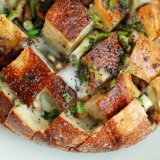

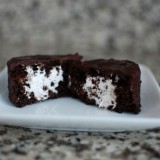
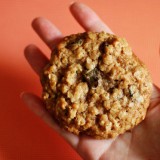
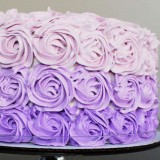
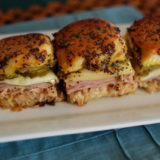


that looks soooo good – I will most definitely be making this soon
This is such a great idea. I will have to try it one weekend for breakfast.
Looks great. Very clever take on pie and I think I’ll be giving it a try myself. Thanks for the idea!
Holy yum – I am making this for my breakfast tomorrow!
OMG, you need to make your own dough – google Artisan Bread in 5 minutes for the recipe.
It takes 5 minutes to make, 2 hours to rise and its enough dough for four 14 inch pizzas, four loaves of bread – and the best part is you can keep the dough in the fridge for up to 2 weeks – just pull out what you need and let it come to room temp.
I don’t like runny eggs either – but my husband loves dipping bread into it – gross! 😀
I might just have to try homemade pizza dough. I think I could handle 5 minutes… Thanks for the info.
That is a gorgeous pizza! I love all the colors and it looks so rustic! 🙂
I don’t know why I have never made one of those either!!
I don’t like runny either, it grosses me out.
I can’t wait to try this over the weekend!
Jenn@ http://www.slim-shoppin.com
Yay, for “pie” I participated too and didn’t make a traditional pie! Oh, geesh, pizza dough is super easy. The ONLY thing with yeast I can do! 🙂 My 9 yr old actually makes it but we use the Artisan Bread in 5 Minutes recipe. Breakfast pizza is a brillant idea can’t wait to give it a try. Psst, I have store bought dough in the fridge too. 🙂
~ingrid
I’ve seen bacon and pizzas pop up a few times, and yours looks so delicious! I really need to give this a try!
Wow that looks delicious!! Good idea with the cookie cutter!
I have made a breakfast pizza before with scrambled eggs, bacon and cheese….but I LOVE the runny egg on it. Good tip with the biscuit cutter making a place for the yolk to nestle. I am gonna try this one. Yummers!
well now i just feel dumb that i didn’t think of this myself! it looks amazing. maybe i will make it and not tell neil that i stole the idea from you…..bwa ha ha ha ha…..
Awesome idea! Love the eggs cooked that way, I don’t do runny either… I made a breakfast pizza for a baby shower brunch, but it wasn’t nearly as healthy, I used gravy for sauce and scrambled the eggs with sausage. Hopefully, we’ll be giving this a try Sunday morning!
What a smart idea to use the cookie cutters; definitely something to try. This looks delicious.
This is one thing I have wanted to try forever!! thanks for the reminder to do this!!! I love the cookie cutter idea to keep the whites in place!
Of course pizza is a pie:) It’s a savory pie. When I first moved to NY from OH I called to order a pizza and said “one large pizza” and the pizza guy said “one large pie” and I got all confused and said “ummm no a pizza” and then I’m pretty sure I heard him a sigh and he said “yes a pie is a pizza”…what a nerd I was.
I was JUST talking to someone about veggie pizza the other day. I love this and your version sounds so good. Can’t wait to try it!
Just to clarify, the whites still ran some, but the yolks definitely stayed in place by using the cookie cutter. Except for the yolk I broke when I was cracking the shell.
Love all the stories about the pizza vs pie thing.
And yes Bec, go ahead and tell Neil you made it up. He’ll love you even more 🙂 I’m wishing I hadn’t told Hubby about it and just surprised him with it this weekend. He’s going to love it (I made it on a day I worked from home).
This looks so delicious…and your pictures are gorgeous! 🙂 I’m SO hungry right now!!!
Thanks so much for participating! I left you instructions for the linky in my blog comments.
holy cow that looks fantastic!!!
That looks awesome!
this looks good, and I know my husband would like it. I might try it tomorrow morning for him. thanks for the idea!!
Those look great! Another way to get my son to eat breakfast. Yay!
this looks omgggg yummmmmmyyyyy
Wow that looks so good and what a great idea to serve for a brunch or breakfast for dinner meal! I am going to try this soon.
OMG!! That looks so good, I might have to make that one morning.
Fabulous! I am a lover of breakfast food and I love this new twist. I even have most of those ingredients at home right now. I think this will be breakfast tomorrow!
What a fun treat before the kids go back to school a n elaborate breakfast. This week I did sangria for recipe sharing. I hope you’ll stop by my site and share this tasty post:
http://momtrends.blogspot.com/2009/07/fridays-feasts-white-sangria.html
What a great idea! It looks really good and perfect for a weekend breakfast!
What a great idea! I love this.
Wow, this sounds amazing!
After finding this recipe yesterday on your blog, I made it for breakfast today. Holy Moly it’s fantastic! I added some sautee’d onions and it was so great. I added it to my blog at
http://cookingwithchristen.blogspot.com/2009/08/pizzaits-whats-for-breakfast.html
Thanks for the recipe!
woww!! this looks delicious, its such a great idea.
Bellacino’s Pizza and Grinder offers Buy One Get One Pizza Free.
I am glad I found your blog. You have wonderful ideas and activities. I am thrilled you are doing the PINK theme.
I make little “wells” in the cheese to hold my eggs in place 🙂